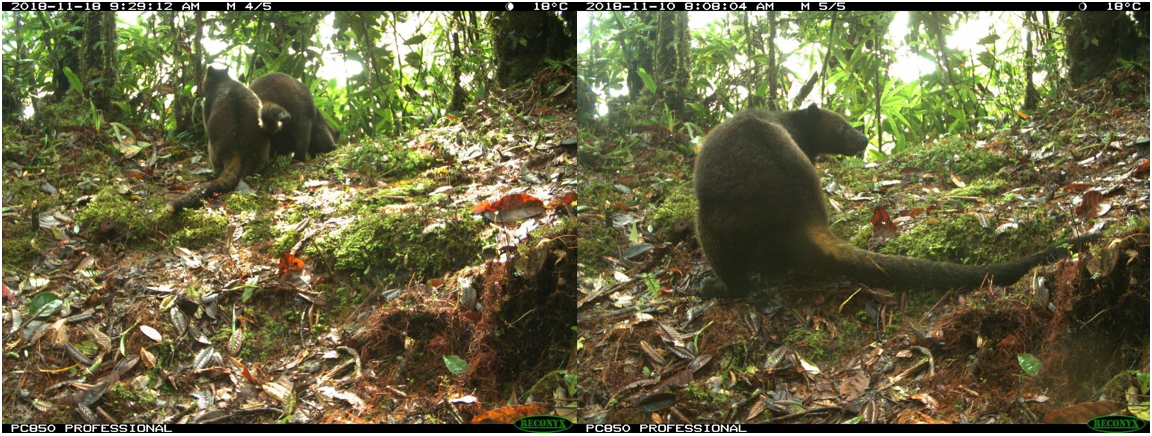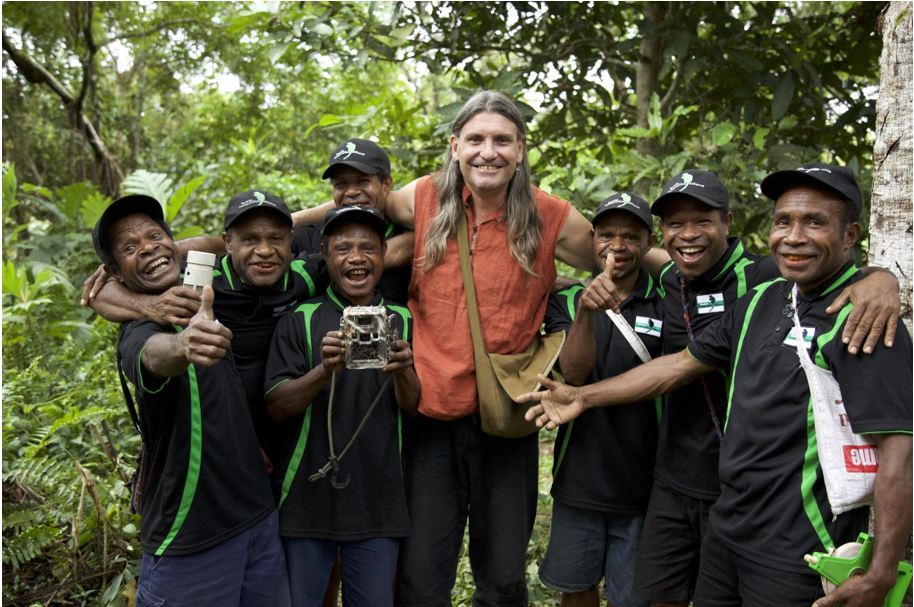- The tenkile tree kangaroo population in Papua New Guinea’s Torricelli mountains has tripled since 1996 to more than 300 animals.
- The Tenkile Conservation Alliance has improved conditions for both the critically endangered species and the local communities.
- The tenkile is still imperiled by deforestation, illegal logging and climate change.
The tenkile, or Scott’s tree kangaroo (Dendrolagus scottae), doesn’t bounce exactly — more of an awkward hop — but the animal is climbing its way back from the edge of extinction in Papua New Guinea.
In 1996 researchers estimated that there were as few as 100 tenkiles left in the wild, making them one of the most threatened mammals in the world, classified as critically endangered by the IUCN. But recent research from the Tenkile Conservation Alliance (TCA) has found that the animal has moved into areas it hasn’t been seen in since the 1960s.
“I feel extremely proud of what TCA has been able to achieve,” said Jim Thomas, the TCA’s founder and CEO. “It’s been a long road, a heap of hard work, lots of sweat and tears, but our persistence and determination has really paid off.”
Founded in 2001, the TCA is a small but dedicated NGO based in Papua New Guinea, working to protect the entire Torricelli mountain range, with the tenkile as its flagship species.
In 2013 the TCA estimated that the tenkile population had tripled to 307 individuals over the past 17 years, and they hope to provide a newer estimate soon. In addition, the TCA’s camera traps have caught footage that provides invaluable behavioral data on these little-studied creatures.

Chubby, placid and curious, these marsupials live in the deep, lush forests of Papua New Guinea’s Torricelli mountain range, feeding on ferns and vines. As there are no monkeys on the island, kangaroos have adapted to fill their ecological niche. Like monkeys, tenkiles and other tree kangaroos are arboreal, with delicate, hand-like paws, and long, non-prehensile tails to act as counterweights when they leap through the canopy. An adult tenkile weighs approximately 10 kilograms (22 pounds), the same as an adult spider monkey. And, like the mythical Australian drop bear, a tree kangaroo can really fall 18 meters (60 feet) from a tree and waddle away uninjured.
Although reclusive, 70 years ago the tenkile was a common sight for the communities of the Torricelli area, and a valuable food source.
European colonization brought an end to that delicate balance. According to Roger Martin’s book Tree-Kangaroos of Australia and New Guinea, European influence led to improved medical care and increased longevity for local communities, but ended their traditional customs such as the ples masalai — a practice of designating areas off-limits to hunters due to fears of evil spirits, where animals could live and breed unmolested. The European colonizers also erased traditional land boundaries and gave guns to hunters. The human population of the area tripled within a single lifetime, requiring more food, and the newly efficient hunters set to work supplying it, bagging as many as six tenkiles in a day.
Although hunting of tenkiles has totally ceased today, the species remains under pressure due to deforestation. Papua New Guinea loses an estimated 1.4 percent of its forest cover to oil palm plantations and logging operations every year. The country also has one of the highest rates of illegal logging in the world, with up to 90 percent of its exported timber having been illegally felled.
That one-two punch of hunting followed by habitat loss led to the tenkile population crashing in the late 20th century. Slow to reproduce, with each female bearing a single joey a year, saving the species seemed an insurmountable task.

So how did the TCA reverse the decline? It did so by working with, instead of against, local communities.
“The landowners and communities of the Torricelli Mountain Range are the custodians of the Tenkile,” Thomas said, adding he sought their approval before moving forward with any TCA project. “The more people we are able to educate, train, and employ, the greater the results for the Tenkile, the environment, the culture and conservation.”
The TCA has already trained a hundred rangers, who conduct biodiversity research and camera trapping.
Using GPS units, TCA staff have mapped the surrounding area and worked with villagers to analyze land use, and determine what areas to farm and which to keep untouched for wildlife. But the new rangers don’t police these areas for poachers, because there’s no need. Thanks to the TCA’s awareness-raising, the local communities haven’t hunted tenkiles in more than a decade. In response, sightings have occurred around the villages of Tolgete and Mupun, where the communities had not believed tenkiles existed, and Yomoum, where there had been no sightings in 20 years.
The TCA also has a strong focus on equality. Thomas’s wife, Jean, is the TCA’s chief operating officer, and the couple have run the organization together for the past 17 years. They ensure that men and women in local communities have an equal voice in designing and implementing projects and that an equal number of men and women are representing their interests in meetings, allowing diverse perspectives on every issue. Their other guiding principle is collaboration.
“We believe that there is no competition in conservation,” Thomas said. “And that conservationists working together, sharing ideas and encouraging one another is a model to moving forward and being successful.”
This focus on support and cooperation has been central to the TCA’s success in engaging with the local communities of the Torricelli mountain range.

To improve food security, the TCA has provided villages with rice-milling machines and relevant training courses. In 2015, the 50 villages within the project area produced only a tonne of rice annually. As of 2019, that figure has increased by a factor of 20; 100 additional villages are now growing rice and millet; and overall health in the region has improved. Communities have also received livestock including rabbits, chicken and fish, as a source of protein that isn’t reliant on hunting.
The recovery of the tenkile is not only a professional success but a deeply personal one for Thomas. “I have only ever seen four Tenkile myself,” he said. “And when I did I literally cried and felt privileged to meet those individuals.”
He’s not the only person deeply moved. Local hunters wept when shown the TCA’s camera-trap pictures of the kangaroo for the first time. “I now know my Tenkile will be seen by future generations after I leave,” Caspar Wakien, a community member, told the TCA. Caspar was 96 years old and died peacefully in his sleep a few weeks later.

As with so many conservation success stories, there is a proviso. Tenkile numbers are on the rise, but timber and oil palm plantations continue to spread. There are also the dangers brought on by climate change, with extreme weather patterns ravaging the tenkile’s remaining habitat. As always, there is a need for stronger government regulations to prevent deforestation, and a role for the global community to play in taking stronger steps to fight climate change.
But the TCA shows how one small yet determined organization, working closely with a committed local community, can make a huge difference. A difference that, for the tenkile, means everything.
Against all odds, this little kangaroo is waddling into the future.